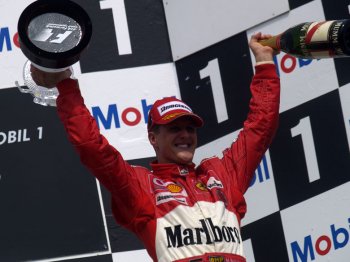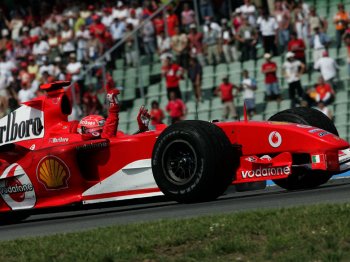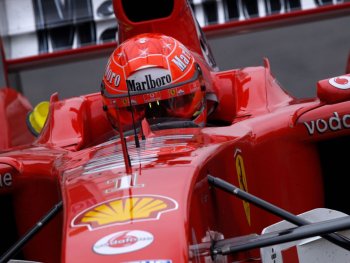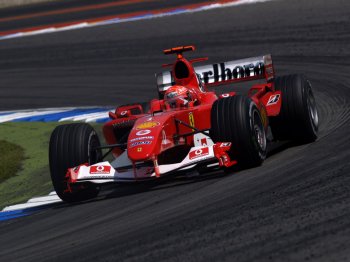|
Whatever the situation in the Drivers’ and Constructors’
championships, it is clear that Scuderia Ferrari is
still as keen as ever to win races and although his rivals
often comment on Michael Schumacher’s seemingly endless
enthusiasm for victory, the fact that this weekend is the
reigning world champion’s home race, adds some extra spice
to his weekend.
Michael can count on the full support of the entire team,
particularly those members directly involved in his car. The
most obvious point of contact between driver and team is his
race engineer, however, as the amount of telemetric data
available has grown over the years, the driver and race
engineer now work with a vehicle engineer, who is one step
removed from the action in the pit garage, as it is his job
to analyse all the data coming off the car. In Schumacher’s
case that role falls to Andrea Stella.
“My job and that of the race engineer are complementary,”
he says. “While the race engineer lives in the garage or on
the pit wall, I am glued to the computer screens studying
the telemetry data to understand how the car is performing,
what are the handling issues, the braking performance and
the traction of the car. Having studied all the data, I then
have to correlate it with our driver’s comments. It is a two
way communication between me and the driver. Together we try
and assess the overall situation with the car, looking to
find areas where we have to improve the set-up, both
mechanical and aerodynamic. Another important part of my job
is to set up the traction control and engine braking and the
differential, which are the “active” systems that we have
running in the car.”
Based on this analysis, Stella then discusses his
findings along with Michael’s race engineer, Chris Dyer. “It
is a team job and Michael is very open to suggestions and to
discussion,” maintains Stella. “Most of our solutions come
from discussion within the team and that is a very enjoyable
way of working.” The fact that Schumacher has a fearsome
reputation for getting involved in every last detail of car
set-up and performance is an added plus for Stella and his
team. “Michael has a very good understanding of the car and
this makes our life much easier in a way, because he can
give you not only the feeling he has from actually driving
the car, but also the feeling on which direction we should
go in terms of setting up the car. In fact, I think he could
almost engineer his own car!”
For Hockenheim, Scuderia Ferrari Marlboro will be
introducing a new aerodynamic package for the German Grand
Prix. “This proves that Ferrari is still pushing with the
development programme on the F2005 and we have certainly not
given up,” maintains Stella. “For every race we usually have
something new because we are still fighting to win, whatever
the current situation in the championships. In this
situation, when we have new components, I have seen all the
data produced from testing with them. We have a lot of very
specialised engineers to look after specific areas on the
car, while my job is more related to the overall
car-tyre-performance package.”
|

 |
|
Michael Schumacher -
Ferrari - 2004 German Grand Prix |
|
|

 |
|
Michael Schumacher -
Ferrari - 2004 German Grand Prix |
|
|
So, from behind the telemetry screens, what will the
Hockenheim track serve up for the Ferrari engineers? “In a
way the old Hockenheim, with its very long straights, was
more challenging technically, but the current circuit also
has its own interesting points,” begins Stella. “To get a
good lap time here, you need good braking, good traction and
cars that possess these characteristics will perform very
well. There is an overtaking opportunity, at the hairpin, so
this makes the racing interesting here.
“The track surface gets very hot, which makes life tough
for the tyres. This is a constraint that prevents us running
a tyre that is softer, which ideally is what you want for
good braking and traction. The Stadium area is still very
interesting for the drivers and also for spectators. The
set-up you now use for the complex is actually similar to
the rest of the track, whereas in the past, you had to face
the big challenge of getting the cars to work in the Stadium
with the very low downforce you had to adopt for the long
straights.
I like the last two corners, which is effectively one
long corner, as it is very important for a good lap time.
The drivers never seem to tackle it the same way lap after
lap. In some corners, drivers take an identical approach for
every lap. With Michael, it is definitely different each
time as he has a tendency to improve every lap, which is one
of his trademarks, improving all the time, getting nearer
and nearer to the limits of the car.”
All drivers are keen to shine at their home race and
Stella reckons Schumacher will be no exception to the rule
this weekend. “This is the third year I have worked on
Michael’s car, having started at Monza in 2002. I think for
sure, he wants to do very well in Hockenheim, because it is
his home race and also, because he still wants to win every
race he enters. One can also consider that, earlier this
year, he did not have a good race at the Nurburgring and he
would like to make up for that.”
Whether or not Schumacher feels any additional pressure
at his home grand prix, Stella is looking forward to another
weekend working with his driver. “Working with Michael is
always a pleasure, because not only does he have a good
understanding of what the car is doing, but also he can give
you feedback while driving round the track,” claims Stella.
“He can talk you round a lap in great detail as to what the
car is doing, but the lap time will be no different to when
he drives a lap in silence. I have the impression that while
most drivers need nearly all their brainpower to drive the
car and can only use a tiny percentage to analyse what the
car is doing, Michael can perform at his maximum using only
50% of his brain, leaving the other 50 to think about what
the car is doing and to analyse it.”
|
|
|
|
![]()
![]()